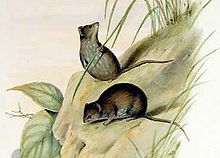Common planigale
| Common planigale | |
|---|---|
 |
|
| Scientific classification | |
| Kingdom: | Animalia |
| Phylum: | Chordata |
| Class: | Mammalia |
| Infraclass: | Marsupialia |
| Order: | Dasyuromorphia |
| Family: | Dasyuridae |
| Subfamily: | Sminthopsinae |
| Genus: | Planigale |
| Species: | P. maculata |
| Binomial name | |
|
Planigale maculata (Gould, 1851) |
|
 |
|
| Common planigale range | |
The common planigale (Planigale maculata), also known as the pygmy planigale or the coastal planigale, is one of many small marsupial carnivores known as "marsupial mice" found in Australia. There they fill a similar niche to the insectivores of other parts of the world.
The common planigale was first described by John Gould in 1851. It was originally described as Antechinus maculatus, and it was retained in the genus Antechinus until Mike Archer transferred it to Planigale in his 1976 revision of the latter genus. The species' scientific name means "spotted flat-weasel". Two subspecies are recognised:
As a "marsupial mouse," the common planigale lies somewhere between a mouse and a shrew in shape. Its body is covered in fur, though that of the tail is sparse when compared to the rest of the body. The underside of its coat is a light grayish yellow color, while the rest varies by individual from gray to a cinnamon color. This species is the largest of the genus, with a body and head length of about 100 mm (3.9 in) and a tail length of about 80 mm (3.1 in). Typical weights are close to 15 g (0.53 oz) for males and close to 11 g (0.39 oz) for females. The head of the common planigale is very narrow, giving it a flattened appearance, though less so than other planigales. Females have a well-developed pouch that opens toward the rear.
The gestation time for common planigale is 19–20 days. At the end of that period, the female gives birth to 5-11 young; the number varies but tends to be consistent with the number of teats the female possesses. They are born at an early stage in development and migrate to the pouch, where they suckle until they are fully developed. Young fully emerge from the pouch around 28 days of age, begin eating solid food at around 55, and are independent of the mother at 70. Breeding begins at around 290 days, later than many similar species. Males continue breeding until at least 24 months of age. Females are polyestrous and can raise several litters a year; in captivity, breeding takes place year-round.
...
Wikipedia

